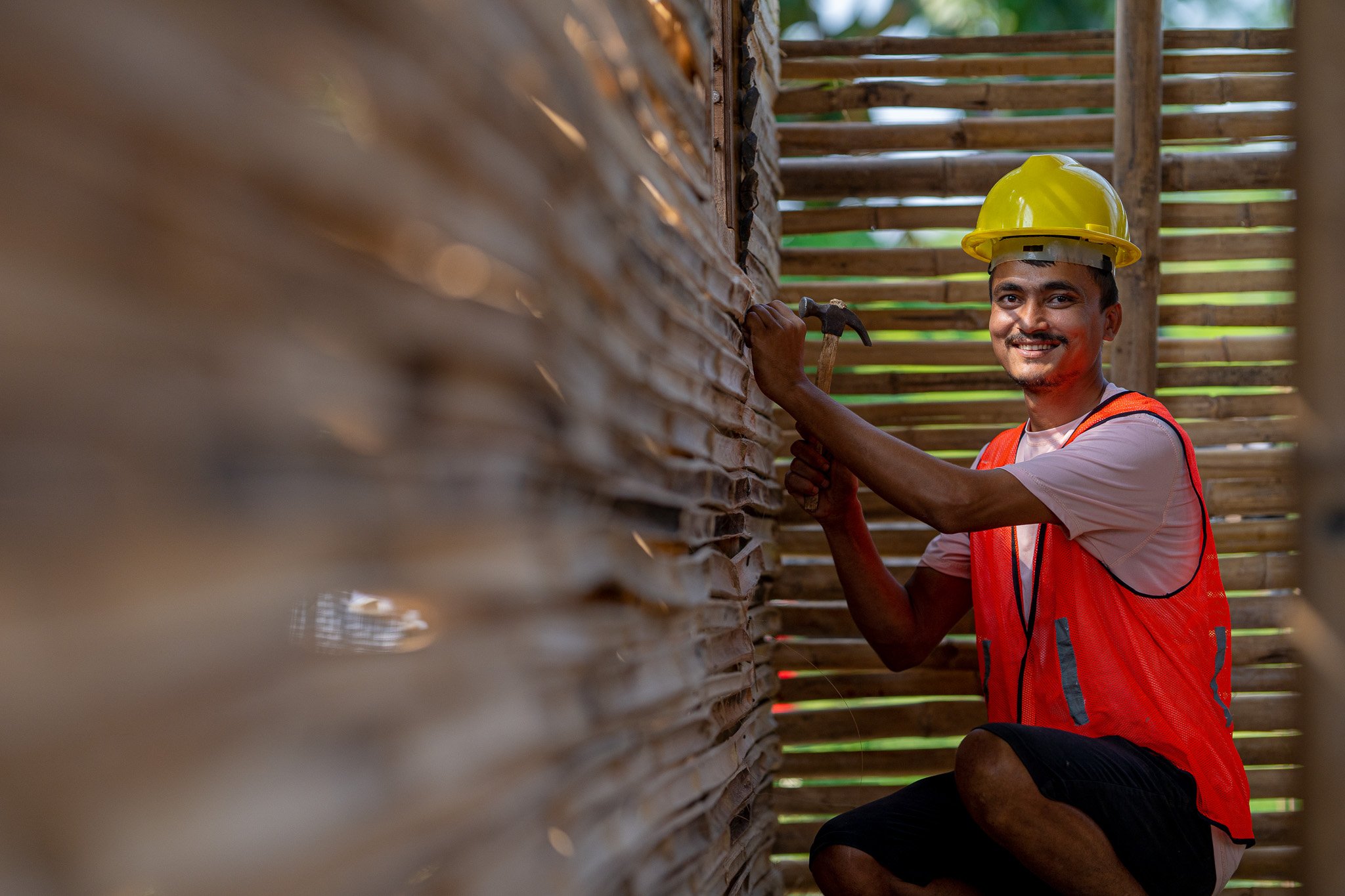SUSTAINABLE HOUSING SOLUTIONS FOR NEPAL
Advancing Bamboo Building Technology
In Nepal's earthquake zone, communities are building disaster-resistant homes using an age-old local resource: bamboo. Traditional wisdom meets modern engineering to create safer, stronger communities.
THE GLOBAL HOUSING CRISIS
The Human Implications
Today, 2.8 billion people lack adequate housing - a number projected to reach 3 billion by 2030. This crisis extends far beyond physical shelter, creating a cycle of challenges that perpetuates poverty:
HEALTH AND SAFETY
Inadequate housing exposes families to serious health risks through overcrowding, poor sanitation, and unsafe construction.
ECONOMIC BARRIERS
Without stable housing, families struggle to maintain employment, build savings, or create intergenerational wealth.
EDUCATIONAL IMPACT
Housing instability significantly affects children's academic performance, limiting their future opportunities.
DISASTER VULNERABILITY
Communities in informal settlements face repeated displacement from extreme weather, creating an endless cycle of rebuilding.
THE GLOBAL BAMBOO BELT
A Natural Solution Rooted in Tradition
What if there was a solution, that was capable of addressing the global housing crisis on multiple fronts?
The Bamboo Belt spans the Global South across Asia, Africa, and South America, where housing needs intersect with natural resources. This renewable material offers unique advantages:
SUSTAINABLE RESOURCE
Fast-growing and CO2-absorbing, bamboo provides a renewable, climate-positive building material.
PROVEN RESILIENCE
In Colombia, centuries-old bamboo structures have withstood earthquakes that damaged modern buildings, demonstrating its untapped potential.
MODERN INNOVATION
The Hilti Foundation and BASE Bahay have transformed this traditional material through CBFT, ensuring bamboo construction meets modern safety standards while remaining affordable.

“Bamboo was overlooked by engineers simply because it doesn’t grow in Europe or North America - where modern engineering originated.”
LUIS FELIPE LOPEZ
General Manager at BASE Bahay
TRANSFORMING BAMBOO INTO A SCALABLE SOLUTION
A Decade of Innovation in Sustainable Housing
The BASE Bahay Foundation, initiated by the Hilti Foundation, represents a milestone in sustainable construction. BASE provides alternative building technologies to enable a network of partners to build quality socialized homes. Homes that are comfortable, affordable, disaster resilient, ecologically friendly, and with social impact.
BASE has developed through three key phases:
INNOVATION ORIGINS
CBFT emerged from groundbreaking research by a Hilti employee, establishing new standards for affordable, eco-friendly housing construction.
PROVEN IMPLEMENTATION
The Philippines, with its challenging environmental conditions, served as the ideal testing ground. The 2021 launch of the BASE Innovation Center in Manila strengthened research capabilities.
VERIFIED IMPACT
With over 1,500 CBFT homes built across the Philippines and Nepal, the technology has demonstrated its scalability and gained governmental recognition.
Cement Bamboo Frame Technology (CBFT)
CBFT combines the durability of cement with the flexibility and sustainability of bamboo, creating disaster-resilient homes that are both eco-friendly and cost-effective. This technology is specifically engineered to withstand severe conditions in disaster-prone areas, such as typhoons and earthquakes, offering safe and lasting housing for vulnerable communities.
REVOLUTIONIZING SUSTAINABLE HOUSING WITH BAMBOO TECHNOLOGY
BASE Innovation Center: Research for Global Impact
The BASE Innovation Center in the Philippines represents the next evolution in affordable housing development. Our state-of-the-art facility advances Cement Bamboo Frame Technology (CBFT) through rigorous research and global collaboration, creating sustainable housing solutions tailored for tropical regions. Working with leading universities worldwide, we're transforming traditional bamboo construction into a scalable, disaster-resistant housing solution.

A MODEL FOR RESILIENT HOUSING
Nepal: Where Innovation Meets Necessity
Following CBFT's success in the Philippines, Nepal emerged as the ideal next frontier for sustainable housing innovation. The country's unique combination of challenges and opportunities makes it perfectly positioned for CBFT implementation:
NATURAL DISASTER RESILIENCE
Nepal's location makes it highly vulnerable to earthquakes, floods, and landslides, demanding housing solutions that prioritize structural integrity.
AFFORDABLE HOUSING NEEDS
Traditional construction materials remain out of reach for many families, creating urgent demand for cost-effective alternatives.
BAMBOO HERITAGE
While bamboo construction is deeply rooted in Nepal's Terai region, modern technology can enhance its durability and disaster resistance.
BRINGING CBFT TO NEPAL
Innovation Meets Tradition
STRONGER, SAFER HOMES
By combining treated bamboo with modern construction techniques, CBFT homes are earthquake- and flood-resistant, offering long-term security for families.
FASTER, COST-EFFECTIVE CONSTRUCTION
Bamboo is locally available and grows rapidly, making it an affordable alternative to expensive, imported materials like concrete and steel.
MODERN MEETS TRADITIONAL BAMBOO BUILDING
CBFT technology elevates Nepal's bamboo construction heritage with enhanced strength and durability while preserving local architectural traditions.

STRENGTHENING THE LOCAL ECONOMY
Growing Jobs Through Bamboo Construction
TRAINING LOCAL BUILDERS
Skilled workers are essential for scaling bamboo construction. Our comprehensive training programs create long-term employment opportunities in cultivation, treatment, and building techniques.
SUPPORTING BAMBOO FARMERS
The growing bamboo construction industry creates stable income for farmers who supply high-quality materials for housing projects.
FOSTERING ENTREPRENEURSHIP
The rising demand for treated bamboo and construction services opens new opportunities for local enterprises and training centers.

BUILDING MORE THAN HOMES
A Mason’s Journey with Bamboo Construction
From basic huts to modern construction, bamboo's transformation in construction parallels one mason's remarkable journey. Through mastering Cement Bamboo Frame Technology (CBFT), he evolved from a skeptic to a skilled builder, securing stable work while remaining rooted in his village. His expertise now creates lasting impact - building resilient homes that strengthen his entire community.
“We truly believe in the potential of bamboo to become a mainstream construction material in Nepal and want to be among the pioneers.”
PRAMOD RAI
Structural Engineer and Co-founder of Kamero Consults, an engineering and construction enterprise in Nepal.

PIONEERING THE FUTURE
Building Nepal’s Bamboo Industry
Nepal's bamboo sector is transforming through parallel innovation streams. A pioneering treatment facility creates sustainable employment while advancing modern construction capabilities. Simultaneously, structural engineer Pramod Rai bridges research and implementation to establish bamboo as a mainstream building material. Together, these initiatives demonstrate how sustainable construction drives both economic development and architectural innovation in Nepal.
A FOUNDATION FOR NATIONAL IMPACT
Government Recognition
“Bamboo houses are essential to Lahan's progress.“
Mahesh Prasad Chaudhary
Mayor of Lahan Municipality
THE POLICY PARTNERSHIP
Working with Nepal's Ministry of Urban Development, we established the country's first bamboo construction guidelines.
FUTURE IMPACT
Local governments across Nepal are now integrating CBFT into their affordable housing initiatives.
NEPAL'S BAMBOO HOUSING REVOLUTION
From Local Success to National Model
CBFT bamboo construction is transforming Nepal's affordable housing landscape. Starting with 30 sustainable bamboo homes in Kanepokhari, this innovative technology has proven its strength and durability. Two municipal leaders now share how these disaster-resistant bamboo houses are creating safer communities and inspiring nationwide sustainable housing initiatives across Terai.
FROM SHELTER TO HOME
Three Stories of Change
In Nepal's rural communities, safe housing was once a distant dream for many families. Now, Reshmi, Gita, and Pramila share their transformative journeys from makeshift shelters to secure bamboo homes. Their stories demonstrate how sustainable housing provides more than just shelter—it creates stability, safety, and new opportunities for Nepal's families.

EDUCATION AND EMPOWERMENT
When Housing Enables Learning
In a CBFT community, volunteer educator Pinky Yadav demonstrates how secure housing enables educational success. Her work with local children reveals the profound connection between stable homes and thriving students, showcasing how sustainable housing creates foundations for both shelter and learning.
GLOBAL COLLABORATION WITH UNIVERSITIES
Research Excellence in Bamboo Construction
BASE Innovation Center in Manila stands at the forefront of bamboo construction research, partnering with over 25 international universities, including ETH Zurich, Coventry University, the University of the Philippines, and Virginia Tech. Through rigorous testing of structural integrity, fire resistance, and environmental impact, researchers are establishing bamboo as a high-performance building material.
ETH Zurich’s study on CBFT, led by Marla Kohli as part of her master’s thesis, demonstrates how scientific research enhances traditional methods, creating more resilient and sustainable housing solutions.






